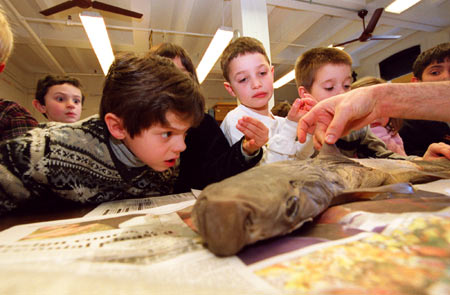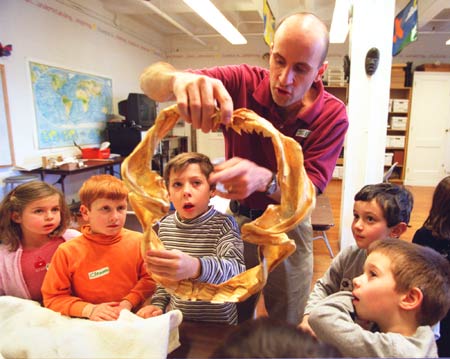Threshers, goblins, and great whites
At HMNH, kids learn everything there is to know about sharks

The race was on. With the Harvard Museum of Natural History’s (HMNH) giant Kronosaurus skeleton as a backdrop, three groups of kindergartners and first-graders began assembling their puzzles, slapping pieces onto the blue-gray carpet until they revealed: A shark, a shark, and another shark.
To be more specific, a thresher shark, with its giant tail fin, a gruesomely grimacing goblin shark, and the dreaded great white.
The 13 schoolchildren were part of a group of Saturday Scholars at the Museum last weekend (Feb. 2). They were in a one-of-a-kind class called “Sharks and Rays” designed for them by instructor Jeff Monchamp, a museum education specialist at the HMNH. Monchamp covered sharks and rays – which are just flattened sharks, according to Monchamp – with age-appropriate presentations, games, crafts, and drills.

During the three-hour class, the children learned that a shark is torpedo-shaped, with fins that help keep it from rolling over (dorsal), help it steer (pectoral), and propel it through the water (tail). They learned that sharks have between five and seven gill slits, have teeth that grow in rows in their mouths and rotate forward as earlier teeth are lost, and that those with narrow pointy teeth eat smaller fish, while those with broader, serrated teeth eat larger prey.
The students got a firsthand illustration of this at snack time, when they had to use a toothpick to poke goldfish crackers from a plate.
“It’s a lot of fun,” Monchamp said of his role as museum educator. “I love the kids and I get to play with animals, plants, and Indian artifacts.”
During the packed program, children learned about sharks A to Z and Monchamp’s presentations kept the children’s attention. After all, what kid wouldn’t be interested in holding a great white shark’s tooth or in examining a real dried fish to see if they could call it a shark? (They couldn’t – having only one gill slit, bony fin supports, and scales instead of a sandpapery skin makes it a bony fish, not a shark.)
The children’s parents are taking advantage of the children’s natural curiosity and sense of wonder to interest them in science early. David Azanow of Natick, whose triplets, Adam, Jake, and Katie, were in the class, said he’s taking his children to Saturday Scholars because he wants to interest them in science before it becomes just another required subject.
“I think it gets them interested in science without having it taught through the book at school,” said Azanow, who admits being awful at science during his own school days. “I hope to get them interested, subtly. Maybe, if I keep dipping them in the water, one day they’ll swim.”
For more information on the Saturday Scholars program, call the HMNH Education Office at (617) 495-2341 between 1 and 5 p.m., visit their Web site at http://www.hmnh.harvard.edu, or check the Gazette Calendar listings.




